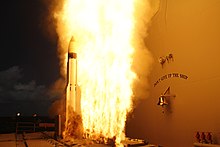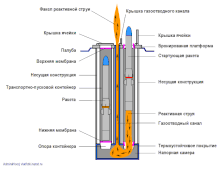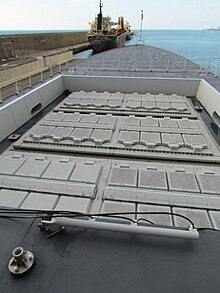Vertical launch system for missiles

A vertical launch system for missiles , in the English language as the Vertical Launching System ( VLS called), is a system that allows both missiles of submarines as well as Überwasserkirche warships can be launched. The rockets stand upright in launch tubes.
Development and use
Originally developed in order to be able to launch the huge ICBMs from SSBNs , many ships now have a miniaturized VLS with which, for example, cruise missiles of the type BGM-109 Tomahawk or anti-aircraft missiles can be launched. The big advantage over other systems is the higher rate of fire (all rockets can be launched very quickly one after the other). Further advantages are the greater tolerance to damage and the reduction in the radar cross-section in comparison to a top-down starter system. In contrast to torpedo tubes , reloading on the high seas is only possible with the help of a tender (supply ship).
Hot start and cold start
There are two ways to launch rockets vertically. When hot start (eng. Hot launch ) the rocket is ignited already in the shaft, at cold start (eng. Cold launch ), it is with gas pressure ( compressed air ejected) from the launch container and ignites after leaving the container their engines. The cold start process is safer for the start environment, while a hot start requires a deflection system for the exhaust gas jet.
technology

The redirected flames from the rocket launch are clearly visible.
The United States Navy's system, known as Mk 41 VLS , can handle missiles of the RIM-7 Sea Sparrow , RIM-162 Evolved Sea Sparrow Missile (Quadpack, see below) and Standard Missile (short- or medium- to long-range AAA). , VLASROC (anti-submarine weapon, which carries a torpedo Mk 46 over water into the target area) and Tomahawk load and fire, an extension of this range is being considered.
A VLS is particularly widespread on ships with the Aegis combat system (e.g. Ticonderoga class ); however, it is also used on non-Aegis ships. Based on the British Duke- class frigates , the VLS has meanwhile also spread to European warships. Modern guided missile destroyers such as the Daring class or guided missile frigates such as the German Brandenburg or Saxony class and the Italian-French Horizon class have VLS for anti-aircraft and cruise missiles.
Western navies use a system that contains one missile per cell, while Russia and the People's Republic of China prefer a revolver magazine that contains several missiles per bay. The only exception are the new ESSM missiles of the western navies, they are stored in so-called quad packs , which means that four missiles can be stored in one cell.
Systems and users
- Mk 41 Vertical Launching System : USA, Canada, Germany, Spain, Netherlands, Norway, Turkey, South Korea, Japan, Australia
- Mk 48 VLS: Canada, Belgium, Japan, Portugal
- Mk 56 VLS: Denmark
- Sylver VLS: France, Italy, Great Britain, Saudi Arabia, Singapore
- GWS 26 VL Sea Wolf : Great Britain, Brazil, Chile, Malaysia


